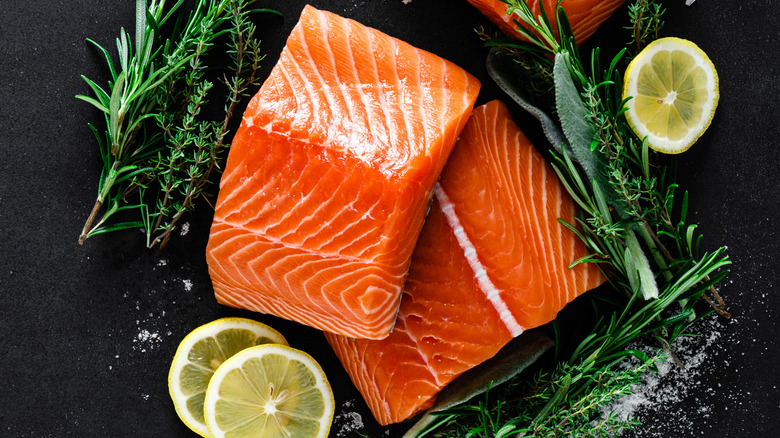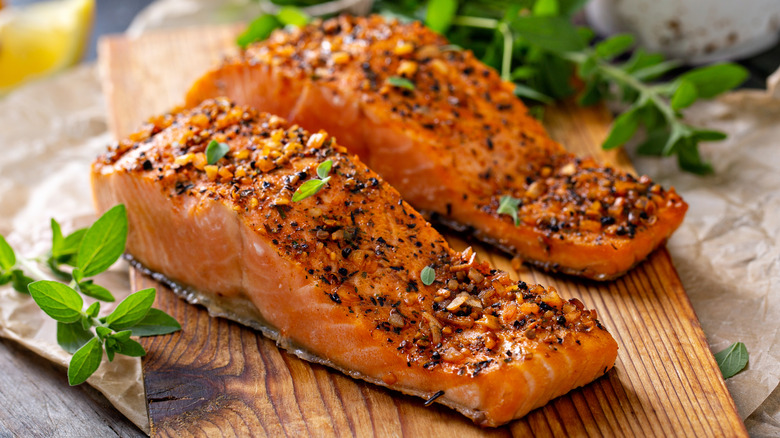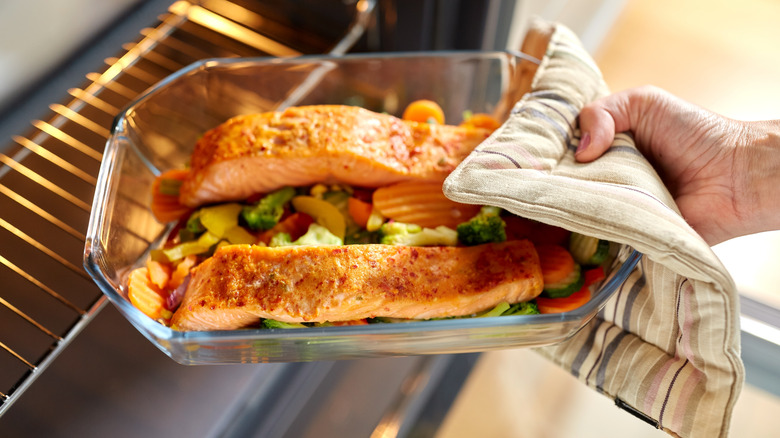What Happens If You Eat Undercooked Salmon?
Salmon makes a delicious dish. Whether it's baked, pan-fried, or grilled, there are many ways to enjoy this healthy fish. WebMD shares that salmon is a great source of protein and contains many essential nutrients including vitamin B12, potassium, iron, and vitamin D. According to Healthline, salmon is one of the most nutritious foods on Earth due to its high amount of omega-3 content. Just 3.5 ounces has 2,260 milligrams of omega-3 fatty acids. They provide many health benefits, such as a decrease in the risk of heart disease and stroke and a reduction in rheumatoid arthritis symptoms (via the Harvard T.H. Chan School of Public Health).
While the benefits of eating this fish are plentiful, there are some drawbacks when you eat salmon that has not been properly prepared. Because sushi and sashimi are commonly consumed, you may be wondering why it's important to cook your salmon before eating it. The reason may be exactly what you think.
Cook your salmon to avoid parasites
A 2017 study cited by the U.S. Centers for Disease Control and Prevention (CDC) found that wild salmon caught in Alaska can be infected with the parasite Japanese broad tapeworm. Food Safety Magazine notes that eating raw or undercooked fish like sushi, sashimi, and ceviche increases the risk of becoming infected with the parasite. In addition to tapeworms, raw salmon can harbor other dangerous parasites, viruses, and bacteria that can make you sick (via Healthline).
"If you're in a high-risk group, don't chance it," wrote private practice performance nutritionist Cynthia Sass for Health. She goes on to explain that when you choose to eat sushi at a restaurant, make sure the establishment is clean and follows all safety protocols. Otherwise, it's a safer choice to order a cooked dish.
To ensure your salmon is safe to eat when cooking at home, freeze it at -4 degrees Fahrenheit for a few days, or cook it to an internal temperature of at least 145 degrees Fahrenheit (via Food Network). The U.S. Food and Drug Administration (FDA) reports that you should freeze your fish before eating it raw, as that will kill some parasites, but the safest way to consume salmon is by cooking it.
You may increase your chances for food poisoning
Salmon that hasn't been thoroughly cooked is susceptible to bacterial contamination, including salmonella and a warm saltwater bacteria known as Vibrio vulnificus (via WebMD). Striking anywhere from six hours to six days following consumption, salmonellosis is commonly characterized by stomach cramping, diarrhea, and fever, all of which can last up to a week, as per the Centers for Disease Control and Prevention. In some cases, symptoms may take much longer to emerge or may continue to linger for weeks after the fact. While salmonella infections often resolve on their own, young infants, kids under 5 years old, older adults, and those with compromised immunity are particularly susceptible to developing severe symptoms.
Vibrio vulnificus infections, while rare, are responsible for the most seafood-related deaths in the country, according to research outlined in Stat Pearls. Leading to gastrointestinal disease, severe wound infection, and sepsis, untreated cases of Vibrio vulnificus infection can be life-threatening. Therefore, eating salmon that's been cooked through and prepared in clean facilities is key to protecting yourself against potential illness.
Signs of cooked versus undercooked salmon
Let's look at some check-list items we can use to determine whether our salmon is undercooked or ready to serve at the family dinner table. Dedicated to providing sustainably-sourced meals, experts at Wild Alaskan Company first advise checking the quality of the meat before you even start to cook it. You'll want to make sure raw salmon isn't giving off any fishy smells. In addition, try out the poke test. Give your thawed salmon filet a light press of the finger, and if the indent returns to its original shape, it's safe for consumption.
And there are a few things to keep in mind during the cooking process as well. While some parts of the fish will cook faster than others depending on thickness, a thoroughly cooked piece of salmon will begin to emit a white coating known as albumin (via Southern Living). Too much albumin, however, may indicate overcooking. Another sign that your salmon is ready and safe to serve is if it flakes easily and effortlessly when you take a fork to it. According to Wild Alaskan Company, if you're struggling to break the filet apart or there are no signs of flaking, your salmon is undercooked and could use a little more time on the stovetop, grill, or in the oven, depending on your preferred cooking method.



